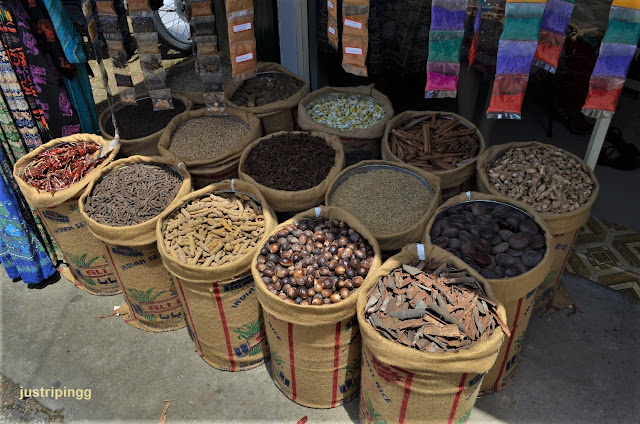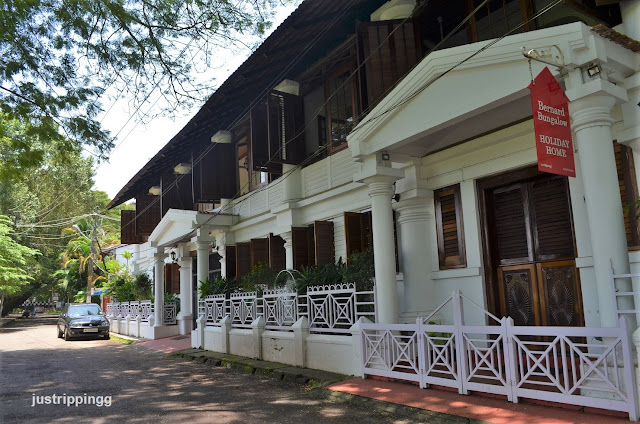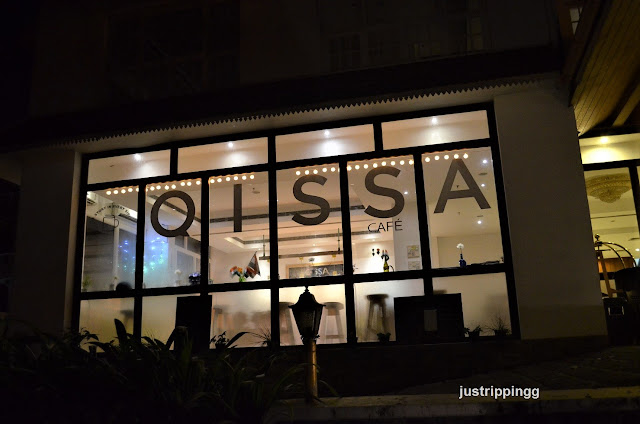Fort Kochi - Where the Streets have names like Princess, Rose, Lily
 |
| Raintree Lodge on Petercelli Street |
 |
| Kerala in Mind! |
--------------------------------------------------------------------
Some Views over the Years - British Library
Plate thirty-four from the first volume of James Forbes'"Oriental
Memoirs", a work in the form of a series of letters richly illustrated,
describing various aspects of nature, people, buildings and places he observed
during his travels in India in the 1760s-70s. In 1772, Forbes(1749-1819) was
appointed Warehousekeeper at the factory in Anjengo, Travancore in South India.
His journey to the South of India took him through the coastal towns of
Tellicherry, Calicut and Cochin. At Cochin he had an official committment to
fulfill on behalf of the Company in connection with the Jews at Mattanchery.
This view of the historic Cochin town, Forbes explains was 'taken from a vessel
at anchor in the road, and includes the handsomest part of the town, with the
entrance of the river. Cochin then belonged to the Dutch, who possessed several
settlements on this part of the Malabar Coast.'

Water-colour painting of the fort of Cochin, from
across the backwater by an unknown artist, c.1800. The image is inscribed:
'View of Cochin'.
Cochin (now called Kochi) is situated on the Malabar coast in Kerala,
southern India. The name probably derives from kocchazhi meaning the new or
small harbour. In the 15th century the area attracted Christian, Arab and
Jewish settlers from the Middle East and from 16th century onwards, the
Portuguese, Dutch and British competed for control of its port and the
lucrative spice trade. The Portuguese fort was built in 1503 and contains many
historic buildings set in winding streets.
----------------------------------------------------------------------
St. Francis Church - Vasco's Original Resting Place
You have no idea why Vasco would keep coming back. Maybe his wives here filed Restitution of Conjugal Rights lawsuits and he had to attend the hearings before the court issued non-bailable warrants.
The St. Francis Church, just like the Santa Cruz Basilica
narrowly missed being demolished by the Dutch. The church was filled with gunpowder all ready for the big bang; maybe the fuse fizzled out. Trust the Europeans to screw up everytime. Vasco's remains were interred here
originally when he died during his third visit to Malabar. His remains were moved to Portugal fourteen years later. Something similar happened to Mumtaz Mahal. Vasco was lucky that he was not around to
see such embarrassing turn of events when Portuguese were routed from their base by fellow
Europeans. Maybe they were all busy attending to the court hearings.
St. Francis Church is probably the oldest European church in India built in 1503 by the Franciscan friars who arrived in the aftermath of Vasco's voyage.
 |
| St. Francis Church in Fort Kochi |
Kochi is all about street hopping and discovering something new around every corner.
 |
| The Bob Marley Cafe in Fort Kochi |
The Bishop's House was originally built in 1506 as the residence
of Portuguese Governor. The house then changed hands from Dutch to English.
Wonder why everybody decided not to demolish it? Maybe the occupants loved the
place and thought they would be back soon in this European theatre of
upmanship.
 |
| The Bishop's House in Kochi |
 |
| Dutch Cemetery in Fort Kochi - another one in a series of Dutch cemeteries you have seen across the country |
Let us swing by
the sea for few minutes. You will come back to see the Chinese Fishing Nets in
the evening.
 |
| Beach Walkway - Fort Kochi |
 |
| Steam Boilers probably used on ships displayed on the beach front |
 |
| Mahatma Gandhi Beach in Fort Kochi |
 |
| Dark Clouds approaching - monsoon time in Fort George |
Let us now hop over to Mattancherry, the other end of the town on the East.
Mattancherry Palace is the go to place here first. The palace was built by the
Portuguese in 1555 and gifted to the Raja of Cochin. Later, instead of
demolishing, the Dutch would renovate it and rename it as the Dutch Palace.
The staircase takes you to the first
floor with the ticket counter. Photography is restricted inside. The central
hall decorated with a series of chandeliers is where the coronation of Cochin
rulers took place. Murals on the walls depicting scenes from Ramayan and
Mahabharat are breath-taking. There are portraits of kings, exhibits of clothes
of royal ladies, and other lifestyle displays.
 |
| Mattancherry Palace in Fort Kochi |
 |
| Fort Kochi - Second Half of the Day takes you to Mattancherry and then to the Chinese Fishing Nets |
 |
| Dutch Palace Pond at Mattancherry |
 |
| Mahavishnu Temple |
Walk to the Jew Town
built around the Paradesi Synagogue with a clock tower. Again photography is prohibited
inside the synagogue. The synagogue was built in 1568 probably by the new wave
of Jews who came to Kerala in early 16th century. These 'White Jews' were
called Pardesi while the Jews who came in the 1st century are called 'Malabari
Jews'. There is a painting of the Raja of Cranganore - probably Muziris -
receiving the Jews. From what you have noted down in your notebook, the
Synagogue has a pulpit in the middle (yes that is what you noticed in the three
synagogues you saw in Kolkata). The altar has a green curtain. The floor has
blue tiles (Lonely Planet says they are hand painted tiles brought from China
and they make an appearance in Salman Rushdie's novel, The Moor's Last Sigh), the ceiling has
chandeliers all around while one side has colourful glass lamps.
 |
| Walking the streets of Jew Town - Fort Kochi |
----------------------------------------------------------------------------
Sarah
Cohen – An End of an Era
You are excited when you
spot a photo you clicked in the Jew Town. The house belongs to Sarah Cohen, the
oldest Paradesi Jew. She would be close to 100 now. And then you see the news
you did not want to. Sarah passed away last year, few days before she would
have celebrated her 97th birthday.
 |
| Sara Cohen - Photo Credits - First Post & Livemint |
Her passing away marks the end of
an era. But for Kochi, Sarah was another tessera in the wonderful mosaic that
the town has woven over thousands of years as people, religions, nations,
communities have intermingled in one of the country’s last outpost of tolerance
and multiculturalism.
 |
| Sarah Cohen's house in Jewtown - Fort Kochi |
With Sarah’s passing, they
say only two ‘White Jews’ are left in Kochi as most have made their way home to
Israel as part of Aliyah. Sarah and her husband had no kids and she spent her
time sitting in the recliner selling hand embroidered covers, scarves, dresses
and kippas.
She was laid to rest in the
Jewish Cemetery in Mattancherry.
-------------------------------------------------------------------------
Pardesi Synagogue and Jew Town
 |
| Entrance to Paradesi Synagogue |
 |
| The sanctuary of the Paradesi Synagogue, Jew Town - photo credit - Wiki |
 |
| The Clock Tower built in 1760 - Pardesi Synagogue |
 |
| Jewish Cemetery, Mattancherry, Fort Kochi |
 |
| Jewish Cemetery where Sarah Cohen was buried |
 |
| Colours of Jew Town, Fort Kochi |
 |
| Ferry service to Ernakulam |
 |
| Coonan Cross Church in Mattancherry also called as Our Lady of Life's Church |
 |
| Ginger House - Spice district of Mattancherry |
 |
| Aspinwall House - it has been restored now and is a major venue of Kochi Muziris Biennale Festival |
----------------------------------------------------------------
The Chinese Fishing Nets of Fort Kochi
What is Qutb Minar to Delhi, the Chinese Fishing Nets are to
Kochi. Make sure you have taken up position here before sunset. This stretch of seafront
is the most photogenic as these giant-insect like cantilevered nets provides
the perfect frames for photography. The sky changing colours, a wading warship,
fishermen hauling up and dropping the nets; all combine to
provide these unforgettable sublime moments in this perfect city.
You are talking to the fishermen. The Chinese Fishing Nets have owners while a group of fishermen rent the nets and pay 3% cut of income derived from catching fish. These nets you see have been here for more than 25 years. There were more on the beach further ahead but now only these twenty to twenty five have survived. Some have collapsed while others have become un-operational due to sand bars. Some nets have turned mechanical; an ode to the modern times.
------------------------------------------------------------------
It is Independence
Day and there are celebrations going on at the beachfront hosted by Indian Navy
and Kerala Police. You are treated to live music, songs and dances. The city keeps surprising you.
But the city is not done yet. Once it gets dark, you go back to the sweetly named streets as the cafeterias and shops glow in the dark again giving you a chance to go street hopping late into the night.













































































































No comments:
Post a Comment